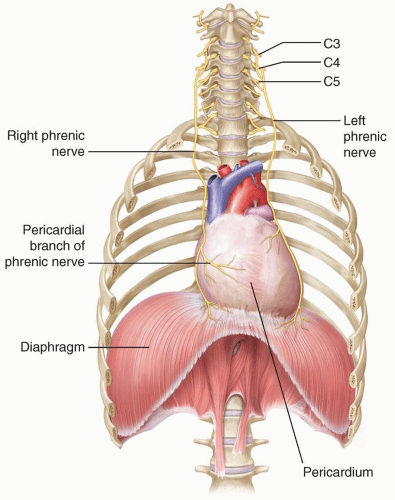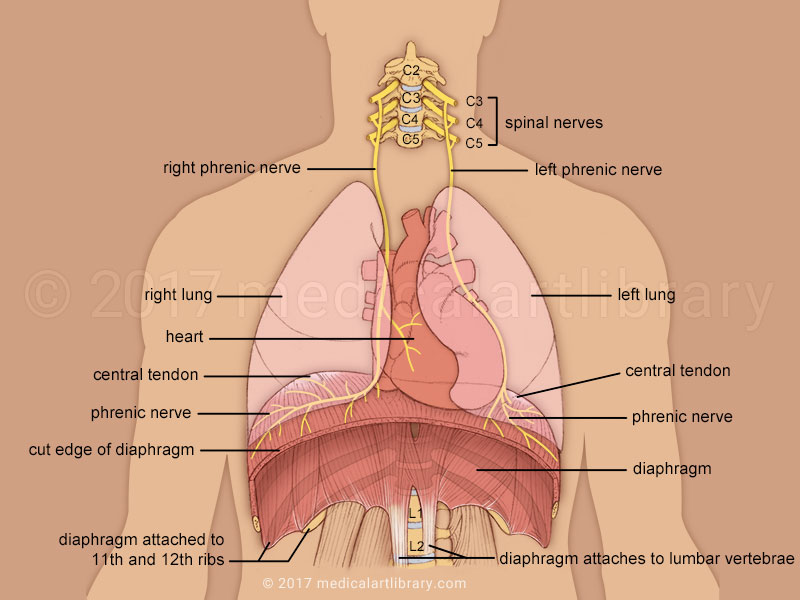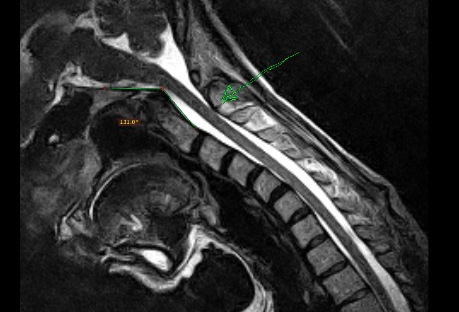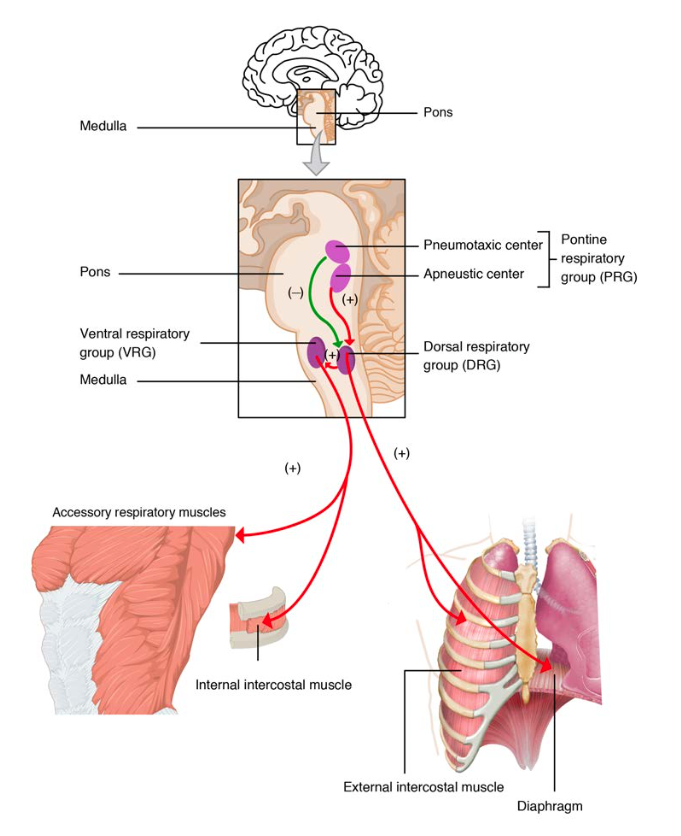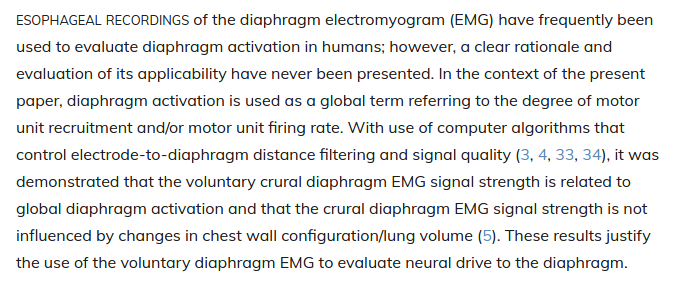I have read the whole thread, which describes a horrible situation, overlooking a vital problem with a patient, plus misdiagnosing her
That will likely repeat in other patients if nobody takes it as what it really is: a dire threat
(Read the quoted thread first) #FOAMed
#FOAMed
(1/n) https://twitter.com/jenbrea/status/1336732558453719043
That will likely repeat in other patients if nobody takes it as what it really is: a dire threat
(Read the quoted thread first)
 #FOAMed
#FOAMed (1/n) https://twitter.com/jenbrea/status/1336732558453719043
Central apnea occurs in many situations, and cranio-cervical instability is definitely the most common
Why does apnea happen?
Because the diaphragm (an essential muscle for breathing) doesn't activate
Why does apnea happen?
Because the diaphragm (an essential muscle for breathing) doesn't activate
The breathing impulse gets carried from the brainstem respiratory centers, via brainstem and spine, until it reaches about the 4th cervical/neck vertebra (C4)
Then it exits the spine down to the diaphragm
Anything that compresses the medulla at C4 or above, affects its function
Then it exits the spine down to the diaphragm
Anything that compresses the medulla at C4 or above, affects its function
Cranio-cervical instability means *inappropriate positioning AND/OR movement of the cervical vertebrae* (including fracture), thus compromising spinal cord, and potentially also the nerves that come out of it
This and other basicranial conditions can affect diaphragm function
This and other basicranial conditions can affect diaphragm function
Our breathing impulse can be affected by any injury occurring between the brainstem and C4-C5, and this can occur without affecting other nerves.
But even the ones that exit downwards in the thoracic or lumbar spine can be spared while the diaphragm fails.
But even the ones that exit downwards in the thoracic or lumbar spine can be spared while the diaphragm fails.
Why it matters?
Diaphragm & part of intercostal muscles are *essential* for breathing, but aren't the only ones
We have accessory ones for inspiration only, & others for expiration
Inspiratory muscles are in neck & thorax
Expiratory are mainly in abdomen https://twitter.com/jenbrea/status/1336736252050034689
Diaphragm & part of intercostal muscles are *essential* for breathing, but aren't the only ones
We have accessory ones for inspiration only, & others for expiration
Inspiratory muscles are in neck & thorax
Expiratory are mainly in abdomen https://twitter.com/jenbrea/status/1336736252050034689
But the only one that can offer proper breathing effort for a sustained amount of time (basically our entire lives) is the diaphragm.
Accessory inspiratory efforts are very noticeable to the trained eye. The patient "gasps" and shows other signs they're having distress.
Accessory inspiratory efforts are very noticeable to the trained eye. The patient "gasps" and shows other signs they're having distress.
Because emergency inspiration (via accessory muscles) is precisely what acute COVID patients have.
They breath quickly, superficially and with high frequency, with a typical intercostal and neck pulling
They breath quickly, superficially and with high frequency, with a typical intercostal and neck pulling
These respiratory efforts don't last much (we must remember that they're helping the diaphragm, when it doesn't get enough air into a rigid, heavy, liquid-filled lung)
Those muscles aren't made for long-term efforts, so the patient gets tired soon (needing emergent intubation)
Those muscles aren't made for long-term efforts, so the patient gets tired soon (needing emergent intubation)
When the brainstem or the neck spinal cord have certain injuries, it can happen that these injuries affect the nerves that make the diaphragm work,
but don't affect the ones that make accessory muscles work (accessory muscles come out of the spinal cord mainly in thoracic levels)
but don't affect the ones that make accessory muscles work (accessory muscles come out of the spinal cord mainly in thoracic levels)
Hence, from the outside (again without taking into account the patient's own sensation) if diaphragm isn't working but the accessory muscles seem to move, *it may appear* as if the patient is breathing/moving their chest, when in fact they're not having an effective gas exchange
This is important. We're talking about a severe condition: bilateral diaphragm dysfunction, caused by spinal cord injury
Which is being reliably told by a patient, but based on circumstantial data (like uneffective chest movements), it's dismissed & ignored
And it keeps happening
Which is being reliably told by a patient, but based on circumstantial data (like uneffective chest movements), it's dismissed & ignored
And it keeps happening
So, what can doctors do to document these events?
There are many ways to monitor the brainstem and the cervical spinal cord
But there's also a way to, uninvasively, monitor diaphragm function: esophageal electrodes https://twitter.com/jenbrea/status/1336737345077297152
There are many ways to monitor the brainstem and the cervical spinal cord
But there's also a way to, uninvasively, monitor diaphragm function: esophageal electrodes https://twitter.com/jenbrea/status/1336737345077297152
We sometimes use this to synchronise patients to ventilators in the ICU. They can be introduced in the same way as any feeding tube (but either via nasal or orally)
They have a set of electrodes that descend until the distal part of the esophagus where it contacts the diaphragm
They have a set of electrodes that descend until the distal part of the esophagus where it contacts the diaphragm
This is just an idea of what can be done, but the most important thing we need to know is that this condition should be adequately recognised, properly documented, and properly, safely managed.
https://journals.physiology.org/doi/full/10.1152/jappl.1998.85.6.2146
https://journals.physiology.org/doi/full/10.1152/jappl.1998.85.6.2146
Regarding sleep studies and central apnea, some cautions  #CCI https://twitter.com/maureviv/status/1337186034724073473
#CCI https://twitter.com/maureviv/status/1337186034724073473
 #CCI https://twitter.com/maureviv/status/1337186034724073473
#CCI https://twitter.com/maureviv/status/1337186034724073473

 Read on Twitter
Read on Twitter